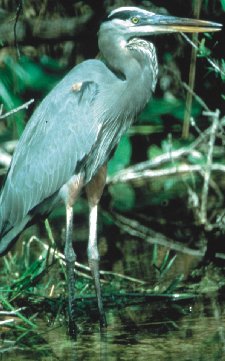This photograph shows a heron. Herons like the Great Blue Heron stand about 4 feet tall and have a wing span of more than 6 feet! Herons like to hunt in the shallow coves of Chesapeake Bay, especially in all of the tributaries that empty out into the Bay. The Bay provides small fish, salamanders, frogs, snakes, lizards, shellfish, rodents and many insects for the herons to feast upon.
Click on image for full size
Courtesy of USGS (United States Geological Survey
Life in Chesapeake Bay
Chesapeake Bay and its watershed support more than 3,600 species of plants, fish and
animals. 2,700 species of plants alone live in the Chesapeake Bay area. These
plants serve as the base for the foodchain in this system. Without these plants, the fish, birds and other animals couldn't exist.
Some of the most important plants in Chesapeake Bay live completely underwater. They are known as SAV or submerged aquatic vegetation. These underwater grasses provide food for fish, birds and shellfish. They also provide a place for fish and other creatures to lay their eggs and hide their young. During photosynthesis, SAV's release oxygen to the water which is necessary for other creatures. Human actions like agriculture, construction, destruction of forests for new malls and parking lots, and pollution threaten healthy growth of SAV. Since the rest of the life in Chesapeake Bay depends on SAV growth, it seems logical that humans need to look closely at things they do that upset the balance for the rest of life in Chesapeake Bay.
The Bay is home to many fish, from the Bay anchovy to the sandbar shark. It supports blue crabs, horshoe crabs and American oysters. In fact, humans get over 500 million pounds of seafood from the Bay each year! Sea turtles, eels, dolphins, rays, seahorses, and jellyfish also fill the Bay waters.
And hundreds of thousands of birds call Chesapeake Bay their home. Some stay all year round, others only winter there. Beautiful species like bald eagles, snowy egrets, great blue herons, geese, swans, ducks and gulls all live in this place.
You might also be interested in:
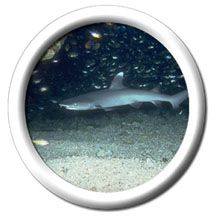
When someone hears the word "shark", they usually think of a mean, scarry monster that eats everything it sees. The movie Jaws helped create this fear. But in real life, sharks aren't so mean. Actually,
...more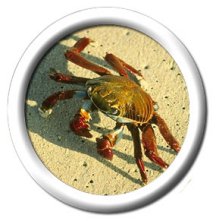
Crabs are crustaceans, which means they have a hard outer-shell that protect the soft body underneath. They also have sharp claws for protection and grabbing food. There are many species of crabs, and
...more
A variety of animals, including snails, octopi and squid, are called molluscs. Over 90,000 species of molluscs are called gastropods. The beautiful shells you see when walking along the beach are probably
...more
An eel is a long, thin creature that looks like a snake in the ocean! Eels range from a few inches to 6 feet in length. Many are very colorful and sometimes scary! Most eels live near corals where there
...more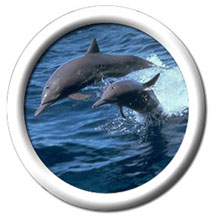
Dolphins are known as cetaceans and are in the order Cetacea. The name Cetacea comes from the Latin 'cetus', which means large marine creature or sea monster! Dolphins are mammals and they do live their
...more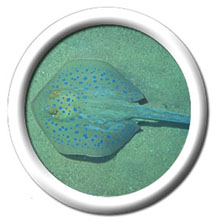
The sea rays are probably the most mysterious creatures of the ocean. Many have soft, widely spanned bodies that flow through the water like silk. They have a variety of appetites--some enjoy corals,
...more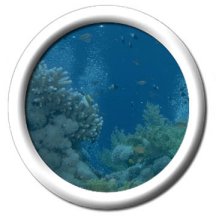
Cnidarians are animals with stinging cells called cnidoblasts. This includes corals, jellyfish and anemones. Cnidarians do not have a head, and commonly look like a flower. The petals are actually tentacles
...more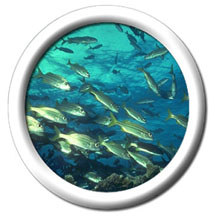
The oceans are full of life. A variety of animals and plants must survive together. Invertebrates like crabs, starfish and worms roam the sea floors. Coral grow in large numbers, creating a home for these
...more


